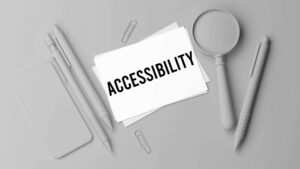Introduction
In this world accessibility is more than a convenience. it is a transforming force that allows individuals with disabilities to participate fully in the digital world. From accessing information and educational resources to engaging in e-commerce and social interactions, the impact of a truly accessible web is far-reaching. However, It demands concrete action in the form of effective recommendations and remediations. Without intentional efforts to address accessibility challenges, we risk creating digital spaces that exclude and marginalize individuals with disabilities. Hence, this blog defines the core of web accessibility, providing insights into the challenges faced by users with disabilities and offering practical recommendations and remediations to making a more inclusive online environment.
Accessibility refers to designing and developing digital content and technology in a way that can be accessed and used by individuals with diverse abilities, including those with disabilities. Accessibility is a legal requirement and a moral and ethical responsibility. It promotes equal opportunities, fosters inclusivity, and improves the overall user experience for everyone.
Common Accessibility Challenges
To begin, let’s identify prevalent accessibility challenges faced by users with disabilities:
- Inadequate Alt Text: Images lacking descriptive alt text present a significant challenge for users relying on screen readers to interpret content.
- Unstructured Headings: Websites with poorly organized or missing heading structures pose difficulties for users navigating through screen readers, disrupting the logical flow of information.
- Non-Keyboard Accessible Elements: Elements that cannot be operated solely via keyboard navigation exclude users who rely on this input method, such as those with motor impairments.
- Insufficient Color Contrast: Poor color contrast can impede users with visual impairments from discerning content, highlighting the importance of clear visual communication.
- Multimedia Without Captions: Users with hearing impairments face barriers when multimedia content lacks captions or transcripts, limiting their access to audio information.
Examples of Barriers Faced by Users
Let’s delve into real-world scenarios to illustrate these challenges:
Scenario 1: Imagine a visually impaired user encountering an image with no alt text, rendering the content inaccessible and devoid of context.
Scenario 2: A user with motor disabilities struggles to navigate a website with complex mouse-dependent interactions, underscoring the need for keyboard-friendly alternatives.
Scenario 3: A user with color blindness encounters text and background colors with insufficient contrast, making it challenging to read and comprehend the information.
Key Accessibility Recommendations
Ensuring web accessibility involves implementing key recommendations that address various facets of user interaction. In this section, we’ll delve into specific elements crucial for creating an inclusive digital environment.
1. Alt Text for Images
Significance of Descriptive Alt Text:
Alt text serves as the eyes for those who rely on screen readers. It provides a textual description of images, enabling users with visual impairments to comprehend the content within.
Guidelines for Effective Alt Text:
Be descriptive and concise.
Convey the purpose and context of the image.
Avoid redundancy with the surrounding text.
Include important details, such as text within the image.
Examples of Well-Crafted Alt Text:
- Image of a Guide Dog: Alt text – “A guide dog assisting its owner across the street.”
- Graph Illustrating Growth: Alt text – “Bar graph depicting significant growth in the past quarter.” Did you know about VPAT and its Importance?
2. Proper Heading Structure
Importance of a Clear Heading Hierarchy:
A well-structured heading hierarchy aids in organizing content, enhancing both visual and screen reader navigation.
Tips for an Organized Heading Structure
- Use headings in a logical order (H1, H2, H3, etc.).
- Ensure each heading accurately represents the content beneath.
- Avoid skipping heading levels.
Demonstrating Screen Reader Interpretation:
Screen readers use heading structures to create a table of contents for users. Consistent and meaningful headings contribute to a seamless reading experience.
3. Keyboard Navigation
Emphasis on Keyboard-Friendly Navigation:
Not all users can rely on a mouse. Keyboard-friendly navigation ensures that everyone, including those with motor disabilities, can navigate your website effectively.
Guidance for Optimizing Keyboard Navigation:
Ensure all interactive elements are reachable via keyboard.
Provide clear focus indicators.
Test and optimize for a logical tab order.
Impact on Users Relying Solely on Keyboard Input:
Users who exclusively navigate via keyboard rely on intuitive and efficient keyboard interactions. Neglecting this aspect alienates a significant user base.
4. Color Contrast
Role of Color Contrast in Accessibility:
Appropriate color contrast is vital for users with visual impairments, ensuring content is easily distinguishable.
Tools and Techniques for Adequate Color Contrast:
Use online contrast-checking tools.
Aim for a minimum contrast ratio (e.g., 4.5:1 for normal text).
Avoid relying solely on color to convey information.
Examples of Good and Poor Color Contrast:
Good Contrast: Dark text on a light background.
Poor Contrast: Light gray text on a white background.
5. Captions and Transcripts for Multimedia
Importance of Captions and Transcripts:
Multimedia content without captions or transcripts excludes users with hearing impairments from accessing valuable information.
Tips for Inclusive Multimedia Content:
Provide accurate and synchronized captions.
Include transcripts for audio content.
Ensure multimedia controls are accessible via keyboard.
Benefits for Users with Hearing Impairments:
Captions and transcripts enable users with hearing impairments to fully engage with multimedia content, fostering a more inclusive digital experience.
As we jump into these recommendations, remember that implementing them collectively contributes to a web environment that accommodates users of all abilities.
Testing and Auditing
Advocate for Regular Accessibility Testing:
Regular testing is the linchpin of a truly accessible website. Advocate for incorporating accessibility testing into the development lifecycle, ensuring that potential issues are identified and addressed early.
Recommend Tools and Methodologies for Comprehensive Testing:
- Automated Testing Tools: Utilize tools like Axe, WAVE, or Lighthouse for initial assessments.
- Manual Testing: Conduct thorough manual testing to catch nuanced issues that automated tools might miss.
- User Testing: Gather feedback from users with disabilities to validate the real-world usability of your site.
I. Benefits of Ongoing Audits
Continuous Improvement: Identify and rectify new accessibility challenges as your website evolves.
Legal Compliance: Stay compliant with accessibility regulations and standards.
Enhanced User Experience: Ongoing audits contribute to an ever-improving user experience.
Promote the wealth of accessibility resources available on a11ytesters.com, including tools, podcasts, and Blogs.
II. Effective Accessibility Recommendations
Adhering to Web Content Accessibility Guidelines (WCAG):
WCAG provides a comprehensive set of guidelines for creating accessible web content. Following WCAG recommendations, such as providing alternative text for images and captions for videos, ensures that content is perceivable, operable, understandable, and robust for all users.
Implementing Keyboard Accessibility:
Keyboard accessibility allows users to navigate and interact with digital content without relying on a mouse. Designing websites and applications with keyboard accessibility in mind enables individuals with mobility impairments or visual impairments who use screen readers to access the content effectively.
Providing Closed Captions and Transcripts:
Including closed captions for audio and video content and providing text transcripts improve accessibility for individuals who are deaf or hard of hearing. It ensures they can access the information provided in multimedia formats.
III. Remediation Strategies
Conducting Accessibility Audits:
Regular accessibility audits help identify areas of improvement and ensure adherence to accessibility guidelines. Audits can be conducted through automated tools or manual evaluations by experts.
Work on Color Contrast:
Ensuring sufficient color contrast between text and background is essential for users with visual impairments or color blindness. Reviewing and adjusting color contrast levels throughout the website or application significantly improves accessibility.
Testing Assistive Technology Compatibility:
Compatibility with assistive technologies such as screen readers or screen magnifiers is crucial. Regular testing with assistive technologies ensures the content is fully accessible and usable by individuals who rely on such tools.
IV. The Benefits of Accessibility
Improved User Experience:
By implementing effective accessibility recommendations and remediations, user experience is enhanced for all users. Clear navigation, descriptive content, and user-friendly interfaces result in a more positive overall experience.
Increased Reach and Engagement:
Creating accessible websites and applications expands the potential audience and allows individuals with disabilities to access and interact with content and services. This increases engagement and potential business opportunities.
Regulatory Compliance:
Adhering to accessibility guidelines and addressing any issues through effective remediations ensures compliance with accessibility laws and regulations, protecting organizations from legal challenges and potential penalties.
By implementing effective accessibility recommendations and remediation strategies, organizations can create digital experiences that are inclusive and accessible to all. From adhering to WCAG guidelines to conducting regular accessibility audits, every effort to improve accessibility contributes to a more inclusive online world. Let us prioritize accessibility as a fundamental aspect of the digital landscape and ensure that every individual, regardless of ability, can fully participate in the online world.



